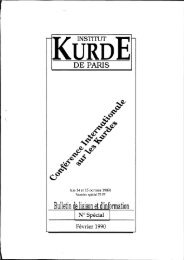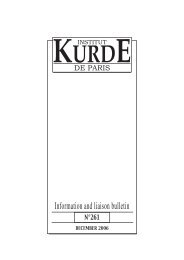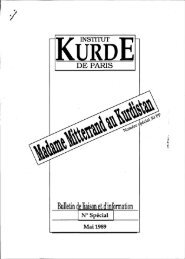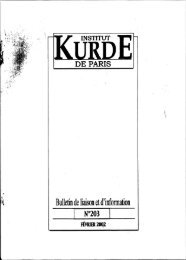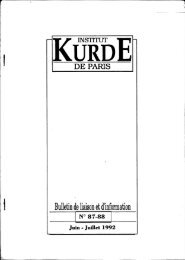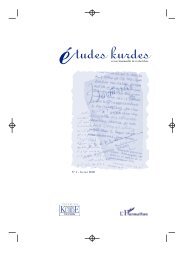Bulletin de liaison et d'information - Institut kurde de Paris
Bulletin de liaison et d'information - Institut kurde de Paris
Bulletin de liaison et d'information - Institut kurde de Paris
Create successful ePaper yourself
Turn your PDF publications into a flip-book with our unique Google optimized e-Paper software.
Revue <strong>de</strong> Presse-Press Review-Berhevoka Çapê-Rivista Stampa-Dentro <strong>de</strong> la Prensa-Baszn Öz<strong>et</strong>i<br />
TOM<br />
The Nation.<br />
BOOKS Ii. THE ARTS<br />
March 23, 1998<br />
Kingdom of Desire<br />
LECLAIR<br />
"~ 0 friends but the mountains," Kurds Western aid to parachute down to their "safe<br />
say. Kurds aren't walking up out haven." Meiselas's next two images explain<br />
of the surf on Long Island or Cape the Kurds' unpreparedness and panic. One<br />
Hatteras, not y<strong>et</strong>. But arriving now shows the town of Qala Diza, every structure<br />
by boatloads in Greece and Italy,<br />
dynamited, flattened to the ground in<br />
Kurds are the Fertile Crescent's canaries, Saddam's "Anf al" campaign of the eighties,<br />
escaping nationai cages, refusing to be poisoned<br />
which razed mountain towns, relocated<br />
again. Iraqi Kurds know another women and children in "victory cities" and<br />
Western attack on Saddam Hussein will mur<strong>de</strong>red men, a systematic genoci<strong>de</strong> with<br />
further impoverish them, already éaught more than 80,000 victims. A photograph of<br />
b<strong>et</strong>ween Saddam 's embargo and the West's a cem<strong>et</strong>ery in Goktapa shows white-daubed<br />
sanctions. Turkish Kurds can smell signs gravestones of Kurds killed by Saddam's<br />
offurther military repression in Turkey's poison gas in 1988. The gravestones, unfinished<br />
recent crackdown on Islamic parties. Americans<br />
rocks, really, are numerous. In the<br />
don't have to befriend Kurds to hear background, those postcard mountains.<br />
their warnings or un<strong>de</strong>rstand the prison Beauty and terror. It's the three-word,<br />
states they're fleeing.<br />
. four-image story of Kurdistan and Kurds.<br />
Many writers have told the Kurds' recent<br />
The rest of Meiselas's book extends the<br />
history. But the photographer Susan<br />
Meiselas's mountain ofa book-388 folio<br />
pages-best introduces and summarizes<br />
Kurds and their kingdom of <strong>de</strong>siI:e located<br />
in eastern Turkey, northern Iraq, northwestern<br />
Iran and northeastern Syria. Kurdis~<br />
tan opens with a postcard, a double-page story back to the 1890s, personalizes it<br />
color photo of mountains in Iraq, a mellowlighted<br />
with photos of famoUs and nameless Kurds,<br />
field in thèforeground, snow-topped wi<strong>de</strong>ns the focus from Iraq to Iran and Tur~<br />
blue peaks in the backgroÙDd, a road barely key, complements the visual story with facsimiles<br />
visible in the upper left comer, no humans<br />
ofremarkably varied texts and puts<br />
in sight. The next image is also a double'- raw materials in context with a cultural historian'<br />
page shot ofIraqi mountains, several miles<br />
s running narrative in chapter intro-<br />
of a winding trail packed with thousands of ductions. Kurdistan haS the emotional impact<br />
Kurds-babies in their arms, sacks on their<br />
of a documentary film and the informa-<br />
backs, suitcases balanceq on their heads~ tional<strong>de</strong>nsity of a document file. One photo<br />
walking toward the camera arid Turkey in shows woo<strong>de</strong>n crates of captured Iraqi<br />
April 1991. This photo is a flashcard, a papers, eighteen tons of them proving the<br />
still flashback to the vi<strong>de</strong>otape that horrified<br />
Anfal genoci<strong>de</strong>, awaiting airlift out ofKur-<br />
Western television viewers after the distan to a safe place. Other photos were,<br />
allies proclaimed "victory" in the GulfWar like assassinated bodies, recovered from<br />
and Saddam's "<strong>de</strong>feated" army took its burial places and, because still subversive,<br />
revenge on panicked Kurds.<br />
smuggled into this collection, a safe haven<br />
City-dwelling Kurds found the mountains<br />
of Kurdish history.<br />
and Turkey unfriendly. Denied entry Heroism was required to take many of<br />
by one of the allies, thousands died on shitstenched<br />
the photographs, and obsession was nee<strong>de</strong>d<br />
mudscapes while waiting for by Meiselas to gather, i<strong>de</strong>ntify and publish<br />
them, activities continuing onher interactive<br />
Tom LeClair teaches at the University of Web site--akakurciistan.com~which offers<br />
Cincinnati. His most recent book is Passing<br />
a sampling of the book's distinctive<br />
Off (Permanent Press), and he 'sjust finished features. Unfortunately,the heroic range,<br />
a novel about refugees in the Middle East. . scale and quality of Kurdista~very page'<br />
Like assassinated bodies, these Photos were<br />
recovered from burial Places and smuggled<br />
into a safe haven of Kurdish history.<br />
is glossy, painstakingly <strong>de</strong>signed, expensive<br />
to produce--places this book beyond<br />
the means ofmany people naturally interested<br />
in its subject. Librarians could be the<br />
Kurds' best friends. But before you razor<br />
out this review and take it to your branch<br />
or send it to your university bibliographer,<br />
.consi<strong>de</strong>r, please, that Kurdistan may well<br />
be worth a place on your coffee table.<br />
This compendium is not just about a<br />
place that impinges on Americans' gas<br />
tanks. The Kurds are not just the Middle<br />
East's Native Americans, a second chance<br />
to expiate some national guilt. The ol<strong>de</strong>st<br />
and largest people--20-25 million-without<br />
a homeland, Kurds represent issues of<br />
<strong>et</strong>hnic and cultural survival everywhere.<br />
Kurdistan fairly poses those issues, questions<br />
the bases cf <strong>et</strong>!1!'jc and racial i<strong>de</strong>ntity,<br />
admits Kurds' struggles with each other,<br />
recognizes the claims of national states.<br />
And more: This massive album treats and<br />
exemplifies how history is ma<strong>de</strong>, how technologies<br />
of representation-such as photography<br />
and print-affect both events and<br />
their recall. And still more: Kurdistan asks<br />
who took the photographs, who wrote the<br />
documents, why and-finally, recursively-why<br />
the materials of history are<br />
arranged as they are.<br />
In the introduction, Meiselas <strong>de</strong>scribes<br />
her book as an archive for a people without<br />
one and as a "mosaic." "Patchwork" might<br />
be a more appropriate <strong>de</strong>scription of Kurdistan-and<br />
of a culture pieced tog<strong>et</strong>her<br />
fromt:nany tribes and several dialects.<br />
Switching back and forth among the four<br />
countries where most Kurds iive, Meiselas<br />
stitches a pattern of repression, rebellion,<br />
repression. When the first photographersanthropologists,<br />
missionaries, adventurers--':showed<br />
up a century ago, Kurds had<br />
an oral culture. The camera was a leap, a<br />
different kind of remembering. In many of<br />
the first shots Meiselas inclu<strong>de</strong>s, Kurdish<br />
lea<strong>de</strong>rs look like Native American chiefs,<br />
proud and in<strong>de</strong>pen<strong>de</strong>nt, but also posed and<br />
welcoming an individual validation that<br />
might be lost in oral history. "That's me,<br />
show it to the great-grandchildren."<br />
Early photography implied culture<br />
was costume and custom. Though Meiselas<br />
doesn't say so, !think photos initially<br />
reinforced the feudal quality of Kurdish<br />
life, discouraging the mass movements<br />
nee<strong>de</strong>d for autonomy or in<strong>de</strong>pen<strong>de</strong>nce.<br />
In the early twenti<strong>et</strong>h century (and<br />
even now), genealogy-conscious Kurds<br />
48





